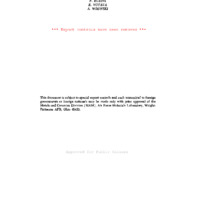-
Title
-
Surface And Interfacial Effects In Relation To Brittleness In Refractory Metals
-
Date
-
1966
-
Index Abstract
-
Not Available
-
Photo Quality
-
Complete
-
Report Number
-
AFML TR 65-226
-
Creator
-
Fourdeux, A.
-
Rueda, F.
-
Votava, E.
-
Wronski, A.
-
Corporate Author
-
Union Carbide European Research Associates
-
Laboratory
-
Air Force Materials Laboratory
-
Extent
-
154
-
Identifier
-
AD0486445
-
Access Rights
-
Export Control
-
Distribution Classification
-
1
-
Contract
-
AF 61(052)-774
-
DoD Project
-
7351 - Metallic Materials
-
DoD Task
-
735101
-
DTIC Record Exists
-
No
-
Distribution Change Authority Correspondence
-
USAFML LTR
-
Distribution Conflict
-
No
-
Abstract
-
An experimental program was conducted to compare the mechanical properties of high purity and impure niobium and the mechanical properties of high purity tungsten, both in polycrystalline and single crystal forms. Slip in high purity niobium takes place on the (110) planes in the (111) directions and yielding is governed by the conservative motion of jogs in screw dislocations, rather than by the unlocking of dislocations from the interstitial impurity cloud. Between the upper and lower yield points there is a sudden generation of a large number of dislocations by double cross-slip mechanism. High purity niobium has greater ductility, higher uniform elongation, increased work hardening, but lower strength than impure niobium. Further, it has a yield point in the temperature range 20 C to 800 C. Appreciable ductility can be achieved at room temperature in commercially pure tungsten, but the mechanical properties are strongly orientation dependent. The ductile-to-brittle transition temperature is about 100 C higher sintered material than in melted material which is of coarser gran size and probably higher purity. Very high purity polycrystalline tungsten was found to show some ductility down to -196 C in the recrystallization condition. However, the fracture process is controlled to a considerable extent by grain boundaries in the temperature range +200 C to -196 C.
-
Report Availability
-
Full text available
-
Date Issued
-
1966-04
-
Provenance
-
Lockheed Martin Missiles & Fire Control
-
Type
-
report
-
Format
-
1 online resource
 AFMLTR65-226.pdf
AFMLTR65-226.pdf